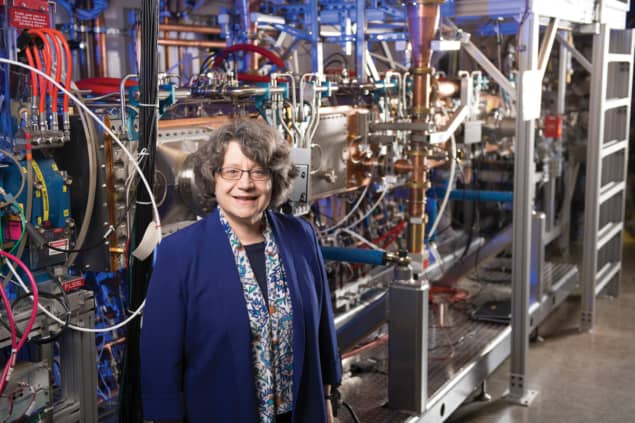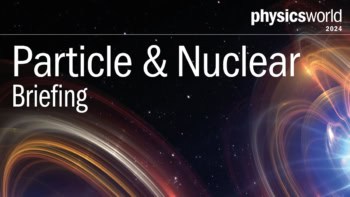The Proton Improvement Plan-II linear accelerator is an essential upgrade to the accelerator complex at Fermilab in the US. The project is being led by the accelerator physicist Lia Merminga, who talks to Physics World about this international effort to keep Fermilab at the forefront of particle physics

The Proton Improvement Plan-II (PIP-II) will be the first accelerator in the US with major contributions from other countries – India, UK, Poland, Italy and France. Is working with major international partners new for Fermilab?
Particle physics is a truly global enterprise because of the sheer size and complexity of projects and the expertise and resources needed. As a result, building and maintaining major facilities is often beyond the capability of a single country. Fermilab is therefore very used to collaborating internationally with partners. We have been contributing to CERN for many years, for example, and we are now building magnets for the high-luminosity upgrade project on CERN’s Large Hadron Collider.
What is new about PIP-II is that it is the first US Department of Energy (DOE) funded accelerator that will be built with significant international participation. Indeed, without our global partners, we could not build PIP-II right now. The partnership includes research institutes, laboratories, and universities in the collaborating countries, so we have had to devise a framework to bring everyone together. This framework includes agreements on several different levels: country-to-country; lab-to-lab; and institute-to-institute. This framework must satisfy DOE rules and the rules of our partner countries. We also need a framework to get the technical work done. As you can imagine, shipping large accelerator components from Europe and India to the US entails more risk than making the components at Fermilab or possibly elsewhere in the US.
We have learned a lot from European accelerator projects, which tend to be international in nature. CERN in Switzerland has been building accelerators with international contributions for decades. Other recent examples include the European Free Electron Laser (XFEL), which began operation in 2017 at DESY in Germany, and the European Spallation Source (ESS), which is being built in Sweden. ESS, XFEL and CERN have all generously shared their experiences with us and we have adapted their approaches to create our own framework – which has been approved by the DOE. PIP-II is not going to be the last DOE project to be built with international contributions – there will be more to come. So, we want PIP-II to provide a successful example that other projects in the US can follow.
Is the design and construction of PIP-II on schedule? And when do you expect to have your first beam?
Before COVID-19 came about, the project was going to be completed at the end of fiscal year 2027. We will, undoubtedly, have some pandemic-related delays so some time in 2028 is a realistic completion date. We expect to have a lower-power beam running by early 2028, so at that point we can start sending beam to Fermilab’s Long-Baseline Neutrino Facility (LBNF). Full-power operation at 1.2 MW will come later.
We have already completed, and are currently commissioning, the PIP-II Injector Test Facility at Fermilab. This is a near full-scale prototype of the first section of the PIP-II linear accelerator (linac). It includes the entire room-temperature front-end section of the machine, which accelerates protons up to 2.1 MeV and two cryomodules that then take the beam up to about 25 MeV. The design energy of PIP-II is 800 MeV, so this is a respectable prototype and will be used as a systems engineering test bed for the front-end of PIP-II.
How will PIP-II be integrated within Fermilab’s accelerator complex?
PIP-II will replace the 50-year-old linac at Fermilab, but it will operate at twice the energy (800 MeV rather than 400 MeV). It will deliver a much higher-quality beam to Fermilab’s existing Booster accelerator, which will increase the proton energy to 8 GeV. Some of these protons will be directed at a variety of physics experiments including several that will look at the physics of muons. Other protons will be sent from the Booster to the existing Recycler- Main Injector complex, which will give the beam a further boost to 60–120 GeV. It is these 60–120 GeV protons that will be sent to LBNF”.
PIP-II is the first US Department of Energy funded accelerator that will be built with significant international participation
What types of experiments will PIP-II support when it is operational?
PIP-II fulfils two missions. The first is to create an intense beam of neutrinos, in fact the world’s most intense beam of neutrinos, for Fermilab’s LBNF. These neutrinos will be sent 1300 km to detectors in South Dakota that are located a mile underground and this will allow physicists to study neutrino oscillations.
Making neutrinos at LBNF involves firing an intense beam of protons at a target. Initially, PIP-II will deliver a beam power of 1.2 MW and we intend to upgrade this to 2.4 MW in the future. PIP-II is needed because the existing Fermilab accelerator complex can only deliver about 750 kW and for technical reasons we cannot push the current technology to 1.2 MW.
The second mission is to support and enable a broad programme of physics research at Fermilab for the international community for many decades to come. Some of this research will be related to muons, which can be created by firing protons at a target. Muons will be studied in detail in several new experiments such as Mu2e-II, which will measure how muons decay to electrons. The aim is to observe forbidden decay processes that would point to physics beyond the Standard Model of particle physics. If they exist, these forbidden processes would be very rare and therefore these experiments will benefit from the large beam power delivered by PIP-II.
Another experiment that could benefit from PIP-II’s proton beam power is based on the η and η’ mesons. These rare particles can be used for searching for physics beyond the Standard Model, provided more than 1013 such particles are produced, which PIP-II makes possible. An experiment has been proposed that utilizes a detector highly sensitive to processes from new physics, but mostly insensitive to background from old physics.
PIP-II can enable a low energy muon programme, using not only its large beam power but also its extremely flexible bunch structure to support two different classes of slow muon experiments, those involving continuous beams and those involving pulsed beams. Muon spectroscopy is being used in a wide range of research areas, including superconductivity, magnetism, battery materials, semiconductors and more.
Last but not least, there is significant interest in using the excess protons at about 1 GeV that PIP-II could provide when operated in continuous mode (total linac beam power ∼2 MW). This could be coupled to a proton storage ring to drive a megawatt-class proton beam dump facility at Fermilab dedicated to and optimized for high-energy physics experiments. This facility would support a rich physics programme, including searches for accelerator-produced dark matter that could explain the observed cosmological abundance and active-to-sterile neutrino oscillations, which would provide evidence for sterile neutrinos.
Will all these experiments be able to operate at the same time?
PIP-II is designed with the ability to distribute the beam to different experiments in programmable bunch patterns. That means we can deliver a bunch pattern that is tailored to the particular requirements of an experiment. This has been used for many years at the Continuous Electron Beam Accelerator Facility at Jefferson Lab in Virginia, where it has been successful at supporting a very productive physics programme.



